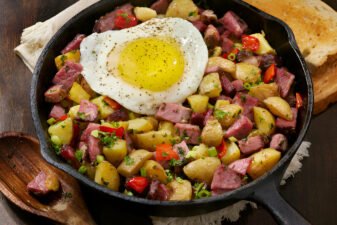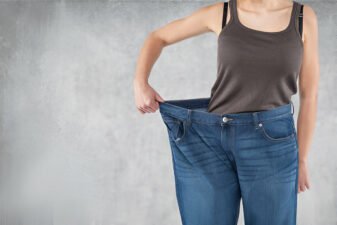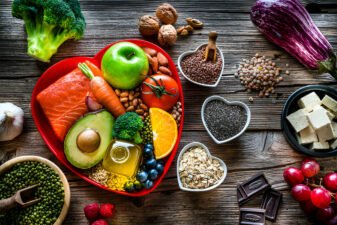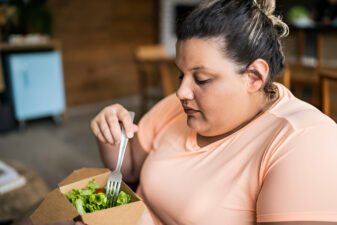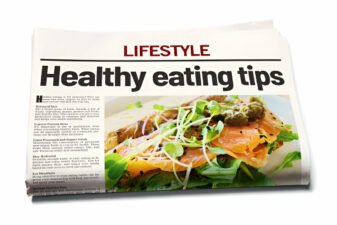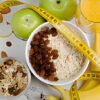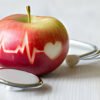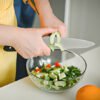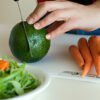A food craving is more than a preference for particular foods, or an impulse to buy certain snacks. A food craving is an insistent desire for a type of food (eg. candy, pizza) which we often go to some lengths to satisfy. Cravings for high-sugar or high fat foods are especially distracting for anyone on a calorie-controlled diet or who is struggling with a weight problem. Fortunately, with a little forethought and planning, it is not too difficult to curb such cravings, although the more support you can get when doing this, the better.
What Causes Food Cravings?
The general consensus among most doctors and dietitians is that cravings stem from a complex combination of emotional, hormonal and biochemical factors. Blood sugar imbalance is seen as the foundation for most cravings, but emotional and hormnal factors are also contributory factors. A small number of cravings can be the result of a food allergy – we crave the very food to which we are allergic! – and a few people still believe that we crave certain foods because our body is “telling us” to remedy a specific nutritional deficiency, although in view of the fact that most of our cravings tend to be for less healthy high-sugar or high-fat foods, this view is now less popular.
Emotional Causes
The most common emotional or psychological triggers for food cravings include: stress, depression, boredom and a general need for comfort. In severe cases, cravings can lead to binge eating and other types of eating disorders. If your yearning for certain foods is causing episodes of uncontrolled bingeing, you must seek help from your doctor.
Hormones
The fact that the strongest food cravings occur in the week prior to menstruation, or during pregnancy, suggests that hormonal swings have an influence on this type of urge to eat. Also, it’s interesting that men – who typically are less affected by hormone imbalance than women – tend to develop fewer cravings.
Low Blood Sugar (Blood Glucose)
A major trigger for food cravings is low blood sugar. This is typically caused by lack of food as a result of going too long between meals/snacks, or following very low calorie diets.
Blood Sugar Imbalance
Studies indicate that people with cravings, especially regular dieters, often have an underlying blood sugar imbalance: meaning, their blood sugar levels fluctuate too much because they eat too much of the wrong type of carbohydrate. Fluctuations in blood sugar can cause cravings, water retention, excessive thirst and mood swings.
How To Reduce Your Food Cravings
Although there is no one-size-fits-all remedy for controlling cravings, most of these urges to eat can be reduced by stabilizing your blood sugar levels. To achieve this, try these healthy eating tips.
1. Eat At Regular Intervals During The Day
If you skip meals (eg. breakfast) or go too long without eating, your blood sugar levels will fall too low, which is a perfect recipe for food cravings, overeating and even binges. Allowing 3-4 hours between meals/snacks is a sensible maximum for women, although 3 hours is better. Men typically can safely wait 4-5 hours. And you don’t need to eat much: even a single oat-cake can be enough between meals to keep eating urges at bay. As well as maintaining stable blood glucose levels, regular eating helps your metabolism to burn calories at an efficient rate. Finally, studies show that regular eating helps to reduce cravings associated with Pre-Menstrual Syndrome (PMS).
2. Do Not Reduce Your Calorie Intake Below A Safe Level
Diets containing fewer than 800 calories a day should ONLY be followed under medical supervision. Weight loss diets with fewer than 1000 calories are not recommended and even those with 1100 calories should only be followed for a short period of time (eg. 14-days). If you want to lose weight, aim for a minimum of 1200 calories, and choose nutrient-dense foods (with high nutritional content) rather than empty-calorie foods/drinks (eg. candy, ice-cream, regular sodas, alcohol).
3. Choose Low-GI Carbs For Optimum Blood Sugar Control
During digestion, the carbohydrate in our food is converted to glucose and then absorbed into the bloodstream to provide energy. Unfortunately, certain types of refined carbohydrate (those with a high-GI value) are absorbed too quickly and raise blood sugar levels too high causing what’s known as a “sugar-spike”. This in turn causes the body to “overreact” and depress blood glucose levels below normal. This yo-yo effect causes all sorts of problems for our mood and appetite, and is a perfect recipe for cravings. To avoid these problems your daily diet should include more low-GI carbs and fewer high-GI ones. Eating less high-GI carbohydrate definitely helps to reduce cravings for sweet things. Here are some specific tips.
- Reduce your intake of refined white flour, heavily processed or high sugar foods
Examples include: fluffy white breads/bread snacks, regular sodas, most regular breakfast cereal, sweets, candy, cookies and cakes. - Increase your intake of high-fiber foods and whole grains
Good food choices include: (1) vegetables, beans and fruit. Note: although fruit contains fruit-sugar, it comes wrapped in fiber which makes it perfectly acceptable when eaten in the form of whole fruit. Fruit juice has a higher GI-value because it contains very little fiber but all of the sugar. (2) whole grain cereals, such as oats, rye, basmati or brown rice, pasta and whole wheat breads/bread snacks.
4. Too Much Added Sugar or Salt Can Make Cravings Worse
If “healthy” foods like fruit, vegetables, beans and oats seem too bland to you, chances are your diet includes too many additives, like sugar or salt. Typically, the biggest culprits are processed or refined foods (eg. canned soup, breakfast cereal, soy sauce, candy, sweets, cakes, cookies, ice cream, regular soda). Since overconsumption of these foods can aggravate cravings, it makes sense to reduce your intake. At the same time, do not add extra sugar or salt to the food on your plate.
5. Reduce Your Intake of Drinks That Act As Stimulants
According to some experts, stimulants (eg. sugar, caffeine in tea/coffee, caffeinated soft drinks) can cause fluctuations in blood sugar, and thus should be avoided or at least consumed in moderation. Switch to herbal teas, spring water and diluted pure fruit juices.
How To Reduce Cravings Before TOM
Lifestyle
PMS cravings occur like clockwork. We know exactly when they are going to happen, so we can easily take preventative action. However, buying a truckload of yummy junk food and then waiting for your cravings to arrive is not the way to go. If you really want to minimize cravings and overeating at this time, you need to stock up with healthy snacks. Healthy foods keep you satisfied longer, help to control cravings and can therefore be eaten with less risk of weight gain. Join Anne Collins forum for extra support.
Healthy Food Choices
- As explained above, choose low-GI carbs, like wholegrain breads, brown rice, basmati rice, wholewheat pasta, noodles, sweet potatoes, rather than refined or processed starches such as white bread, white rice, white pasta, potatoes.
- Choose higher fiber foods, especially those rich in soluble fiber. The best sources of soluble fiber are apples, oats and beans.
- Eat plenty of vegetables. Not only are veggies packed with micronutrients like vitamins, minerals and phytochemicals, as a rule they are also low in calories, high in fiber and (usually) have a very low GI value.
- If possible, combine some fat and protein with your carbohydrate (starch or fruit). This will slow the rise of blood sugar from the carbohydrate. For example, eat toast with two teaspoons of peanut butter.
- Choose lower-GI snack-foods. Instead of donuts, muffins, cakes, cookies, candy, sweets, regular sodas, sugar and honey, switch to snack-foods like: fresh fruit, chopped veggies, sourdough muffins, low-fat yogurt with strawberries, unsweetened canned fruit, nuts and seeds, dried fruit, banana, baked tortilla chips and salsa, hummus, wholewheat pita with salad and light mayonnaise, and drink water instead of soda or coffee.
How To Reduce Cravings For Sweet Things
In addition to following the advice outlined above, there are three steps you can take to control your urge for sweet foods.
Do not exceed the guidelines for refined sugar consumption
According to official recommendations, daily sugar consumption should not exceed 40g of refined sugar per 2000 calories consumed. This equates to 8 percent of calories, and translates to a maximum of 32 grams of sugar per day, when following a 1600 calorie diet plan.
Avoid artificial sweeteners
Even when calorie-free, sugar substitutes can be 200 times sweeter than sugar. Adding these chemicals to your diet will only aggravate your sweet tooth. In fairness, it is not possible to avoid these sweeteners entirely (eg. many low-fat dairy foods depend on them), but watch out for non-nutritious sources such as diet sodas. Certain sweeteners may aggravate symptoms of musculoskeletal rheumatic conditions. For details, see: Fibromyalgia Diet Guide and Fibromyalgia, Aspartame and MSG.
Reduce your intake of packaged, processed or “instant” foods
Heavily processed foods are a miracle of food technology and can be very convenient, even at times essential. But there’s a price to pay. To guarantee the “taste” we demand, producers are often obliged to add extra sugar, salt and fat. By reducing your consumption of this type of “invisible” sugar, and increasing your intake of natural fruit sugars, you will gradually reduce your sugar dependence.
Choose healthier sweet options
Better sweet foods include: fresh or frozen fruit, canned fruit in juice, low-fat yogurt, whole wheat bread with a little jelly and so on.
Are You “Addicted” To Candy or Other High-Sugar Foods?
If you have great difficulty in giving up very sweet foods like candy, chances are that you have a serious blood sugar imbalance or, at least, a very unbalanced diet, so pay particular attention to the dietary advice in this article. As to whether you should continue to eat candy, this is a matter of self discpline. If you can restrict yourself to a small piece, you don’t need to give it up completely. But if you find yourself eating a whole bar because (say) you feel depressed, it makes more sense to exclude this type of food completely from your diet. For extra help, join Anne Collins forum.
Understanding The Digestive System
In order to reduce cravings for certain foods, it helps to understand how food is digested. Our food digestion system (mouth, esophagus, stomach, small intestine, large intestine) helps us to absorb energy and nutrients from food. Carbohydrate, fats and protein are each digested differently within the gastrointestinal tract.
The Importance Of Exercise in Reducing Cravings
Due to the influence of mood on our eating habits, especially cravings, it is vital to take regular physical exercise on most days. Exercise significantly improves mood by releasing chemicals (endorphins) into the bloodstream, and will definitely help you to control your urge to eat. Aim for 30 minutes of exercise, each day, and if your cravings occur at specific times of the day or month, organise your exercise to coincide with these times.
Get Support To Manage Cravings
It’s not always easy to manage cravings, especially if you’re feeling low. So get as much support from other people as you can. If you have difficulty finding help, consider joining an online community. For example, my diet forum offers fantastic support for anyone trying to reduce cravings when dieting, so do check it out.
